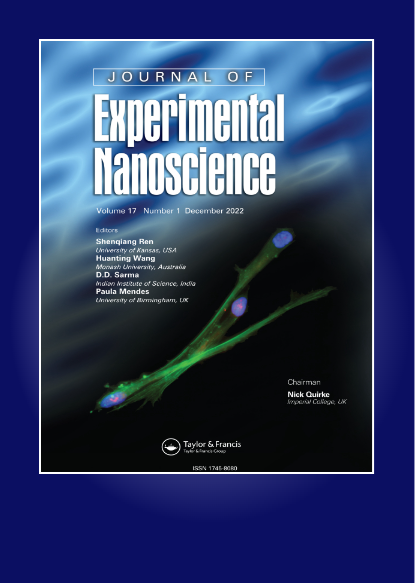Alginate-coated chitosan nanoparticles for pH-dependent release of tamoxifen citrate
IF 2.6
4区 材料科学
Q2 CHEMISTRY, MULTIDISCIPLINARY
引用次数: 4
Abstract
Abstract Chitosan-based nano-sized particles increase the penetration of the drug through the narrow junction into the bloodstream and target the specific site. The objective of this study was to prepare chitosan nanoparticles to entrap a hydrophobic drug (tamoxifen citrate), followed by the alginate coating of the developed nanoparticles to decrease their degradation in the acidic pH. Drug-loaded chitosan nanoparticles were prepared by the ionic gelation method. Alginate coating was done by dissolving sodium alginate to buffer solution and drug-loaded chitosan nanoparticles drop-wise under mild agitation. The size of alginate coated chitosan nanoparticles, zeta potential, surface morphology, in-vitro drug release, and entrapment efficiency was measured. The optimised formulation of both uncoated (SH3) and coated (SH7) formulation showed the particle size, PDI, and zeta potential with values 221 & 338 nm, 0.161 & 0.230 and 36.5 & −20.7 mV, respectively. The resulted nanoparticle surface was non-porous. The percentage yield of the optimised formulation SH3 was 28% and SH6 was 33%. The entrapment efficiency of the optimised formulation SH3 (uncoated formulation) and SH6 (coated formulation) is 69.5 and 58.51%, respectively. Chitosan nanoparticles were successfully prepared to entrap tamoxifen citrate. The coating of chitosan nanoparticles decreased their degradation in the acidic pH.海藻酸盐包被壳聚糖纳米颗粒对柠檬酸他莫昔芬的ph依赖性释放
基于壳聚糖的纳米颗粒增加了药物通过狭窄连接进入血液并靶向特定部位的渗透性。本研究的目的是制备壳聚糖纳米颗粒包埋疏水药物(柠檬酸他莫昔芬),并用海藻酸盐包覆壳聚糖纳米颗粒,以减少其在酸性ph下的降解。将海藻酸钠与载药壳聚糖纳米颗粒在轻微搅拌下滴入缓冲液中,制备海藻酸盐包被。测定海藻酸盐包被壳聚糖纳米颗粒的粒径、zeta电位、表面形貌、体外药物释放和包封效率。优化后的未包覆(SH3)和包覆(SH7)配方的粒径、PDI和zeta电位分别为221和338 nm、0.161和0.230以及36.5和- 20.7 mV。所得纳米颗粒表面无孔。优化后的配方SH3得率为28%,SH6得率为33%。优化后的配方SH3(未包覆配方)和SH6(包覆配方)的捕集效率分别为69.5%和58.51%。制备了壳聚糖纳米颗粒,成功地捕获了柠檬酸他莫昔芬。壳聚糖纳米颗粒的包覆降低了其在酸性pH下的降解。
本文章由计算机程序翻译,如有差异,请以英文原文为准。
求助全文
约1分钟内获得全文
求助全文
来源期刊

Journal of Experimental Nanoscience
工程技术-材料科学:综合
CiteScore
4.10
自引率
25.00%
发文量
39
审稿时长
6.5 months
期刊介绍:
Journal of Experimental Nanoscience, an international and multidisciplinary journal, provides a showcase for advances in the experimental sciences underlying nanotechnology and nanomaterials.
The journal exists to bring together the most significant papers making original contributions to nanoscience in a range of fields including biology and biochemistry, physics, chemistry, chemical, electrical and mechanical engineering, materials, pharmaceuticals and medicine. The aim is to provide a forum in which cross fertilization between application areas, methodologies, disciplines, as well as academic and industrial researchers can take place and new developments can be encouraged.
 求助内容:
求助内容: 应助结果提醒方式:
应助结果提醒方式:


